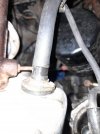Objective
Member
I realise that this is a small detail, but in an attempt to avoid a difficult to replace part, can someone provide their experience on replacing the rubber vacuum hose. The section looping over the 1971 2000 TC engine from the carb is shot. Its been replaced before simply by cutting the hose around 6 inches from the servo and adding a simple, straight-through connector. Now the connector and the original 6" section also needs replacing.
So, to the question . . . the photo shows the jubilee clip removed, which should mean the hose should just pull off. It doesnt ! The fitting into the servo seems to be 2-part. If I apply more pressure, will the hose finally slip gently off, or will the plastic-looking connectors into the servo crack. Would you experienced people just pull off the hose, cut it off or reconnect another straight through connector, safe in the knowledge the original hose will (probably) last another 5 years, no problem.

So, to the question . . . the photo shows the jubilee clip removed, which should mean the hose should just pull off. It doesnt ! The fitting into the servo seems to be 2-part. If I apply more pressure, will the hose finally slip gently off, or will the plastic-looking connectors into the servo crack. Would you experienced people just pull off the hose, cut it off or reconnect another straight through connector, safe in the knowledge the original hose will (probably) last another 5 years, no problem.


